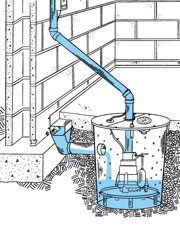Is your basement ready for a big melt?
Now that the gutter problems, ice dams, and roof problems have stopped, it is time to look at your basement. If we get a sudden melt – usually caused by warm rain – basements that tend to flood will. From what I have been seeing and hearing, basements have been handling the brief melt well. We seem to have lucked-out by having a short melt, then a refreeze, overnight.
For those of you who don’t know how sump pumps work, here are the basics:
 A hole is dug under the slab of the basement to form a pit. Water collects in the pit, well under the slab (sometimes as much as 3 feet down, sometimes less.) A pump is set in the middle of the pit, with a switch that goes on based on the rising water level (like a toilet float.) When the ground water rises, the water in the pit gets pumped out by a tube to the outside. When it works right, the water is pumped out and the basement floor no longer gets wet.
A hole is dug under the slab of the basement to form a pit. Water collects in the pit, well under the slab (sometimes as much as 3 feet down, sometimes less.) A pump is set in the middle of the pit, with a switch that goes on based on the rising water level (like a toilet float.) When the ground water rises, the water in the pit gets pumped out by a tube to the outside. When it works right, the water is pumped out and the basement floor no longer gets wet.
Most people in-the-know recommend a perimeter drain. This is like the gutter on your roof. It collect water and directs it into the sump pit.
In addition, a battery back-up and a second pump are a prudent addition.
 Home-made sump pump installations frequently have one or more of these problems:
Home-made sump pump installations frequently have one or more of these problems:
- Many do not have walls in the pit; the pump is put in a muddy hole at the lowest point in the basement. This creates several problems. Mud eventually gets sucked into the pump and the pump will choke to death. If the pump doesn’t die, it keeps sucking the mud under the slab, creating little tunnels under there. In most cases, this won’t matter much, since the slab is not structural. However, if the slab is thin, it’ll start shifting. If the undermining gets to the foundation, the real trouble begins.
- Open sump pump holes allow dampness in the basement, since the water sitting at the bottom of the pit evaporates into the basement. Also, weak covers or no covers make it possible for people and animals to fall in.
- Few have perimeter drains, so other parts of the basement still get wet.
- A sump pump is an appliance working in a wet area. Many are plugged into any old outlet, frequently with a long, dangling extension cord. They don’t have a dedicated outlet. They should.
 Many use flexible hoses as the conduit out of the house. These do not have a check valve, so water can accumulate in the hose, where it is sagging. Another no-no. It wastes energy and can lead to mold issues with the standing water.
Many use flexible hoses as the conduit out of the house. These do not have a check valve, so water can accumulate in the hose, where it is sagging. Another no-no. It wastes energy and can lead to mold issues with the standing water.- Some have drain hoses that are flexible. These can get frozen or clogged and cause the pump to fail.
- Some have hoses or pipes that drain onto the sidewalk. During weather like we are having now, these will cause the sidewalk to ice over at night.
- Worst of all are the home-made sump pumps that drain into a sink or directly into the sewer line. These are illegal. (If everyone’s sump pump drained into the sewer system, the system will get flooded.)
